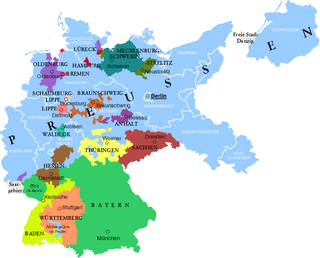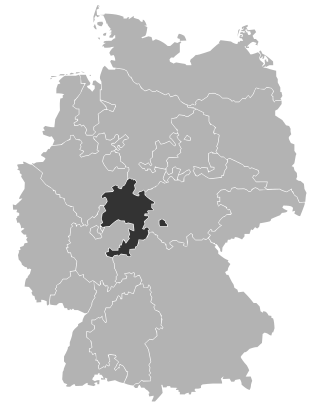Related Research Articles

Bad Arolsen is a small town in northern Hesse, Germany, in Waldeck-Frankenberg district. From 1655 until 1918 it served as the residence town of the Princes of Waldeck-Pyrmont and then until 1929 as the capital of the Waldeck Free State. The International Tracing Service has its headquarters in Bad Arolsen. In 2003, the town hosted the 43rd Hessentag state festival.

This article is concerned with the elections to the Landtag of Bavaria in years of 1919–1933, the period known as the Weimar Republic.

The Evangelical Church of Hesse Electorate-Waldeck is a United Protestant church body in former Hesse-Cassel and the Waldeck part of the former Free State of Waldeck-Pyrmont.
Saale-Holzland-Kreis II is an electoral constituency represented in the Landtag of Thuringia. It elects one member via first-past-the-post voting. Under the current constituency numbering system, it is designated as constituency 36. It covers the northern part of Saale-Holzland-Kreis.
The 1919 Hessian state election was held on 26 January 1919 to elect the 70 members of the Hessian constituent people's assembly.
The 1921 Hessian state election was held on 27 November 1921 to elect the 70 members of the Landtag of Hesse.
The 1924 Hessian state election was held on 7 December 1924 to elect the 70 members of the Landtag of Hesse.
The 1927 Hessian state election was held on 13 November 1927 to elect the 70 members of the Landtag of Hesse.
The 1931 Hessian state election was held on 15 November 1931 to elect the 70 members of the Landtag of Hesse.
The 1932 Hessian state election was held on 19 June 1932 to elect the 70 members of the Landtag of Hesse.
The 1922 Saxony state election was held on 5 November 1922 to elect the 96 members of the Landtag of Saxony.
The 1932 Thuringia state election was held on 31 July 1932 to elect the 61 members of the Landtag of Thuringia.
The 1924 Mecklenburg-Schwerin state election was held on 17 February 1924 to elect the 64 members of the Landtag of the Free State of Mecklenburg-Schwerin.
The 1920 Mecklenburg-Strelitz state election was held on 16 May 1920 to elect the 36 members of the Landtag of the Free State of Mecklenburg-Strelitz.
The 1927 Mecklenburg-Strelitz state election was held on 3 July 1927 to elect the 35 members of the Landtag of the Free State of Mecklenburg-Strelitz.
Landtag elections in the Free State of Lippe (Freistaat Lippe) during the Weimar Republic were held at irregular intervals between 1919 and 1933. Results with regard to the total vote, the percentage of the vote won and the number of seats allocated to each party are presented in the tables below. On 31 March 1933, the sitting Landtag was dissolved by the Nazi-controlled central government and reconstituted to reflect the distribution of seats in the national Reichstag. The Landtag subsequently was formally abolished as a result of the "Law for the Reconstruction of the Reich" of 30 January 1934 which replaced the German federal system with a unitary state.
Landtag elections in the Free State of Schaumburg-Lippe (Freistaat Schaumburg-Lippe) during the Weimar Republic were held at 3-year intervals between 1919 and 1931. Results with regard to the total vote, the percentage of the vote won and the number of seats allocated to each party are presented in the tables below. On 31 March 1933, the sitting Landtag was dissolved by the Nazi-controlled central government and reconstituted to reflect the distribution of seats in the national Reichstag. The Landtag subsequently was formally abolished as a result of the "Law for the Reconstruction of the Reich" of 30 January 1934 which replaced the German federal system with a unitary state.
The 1919 Waldeck state election was held on 9 March 1919 to elect 21 Constituent State Repesentatives of the Free State of Waldeck-Pyrmont. It was the only election conducted in the unified state before Pyrmont was detached and made part of the Free State of Prussia on 30 November 1921.
The 1925 Waldeck state election was held on 17 May 1925 to elect the 17 Landesvertreter of the Free State of Waldeck. This was the last election conducted in Waldeck before the state merged with the Free State of Prussia on 1 May 1929.

State elections in the Free State of Waldeck during the Weimar Republic were held at 3-year intervals between 1919 and 1925. Results with regard to the total vote, the percentage of the vote won and the number of seats allocated to each party are presented in the tables below. Pyrmont, in accordance with the results of a plebiscite, was detached from Waldeck and incorporated into the Free State of Prussia on 30 November 1921. Following a second plebiscite, Waldeck itself also subsequently merged with Prussia on 1 May 1929.
References
- 1 2 Gonschior, Andreas. "Der Freistaat Waldeck Landesvertretungswahl 1922". Wahlen in der Weimarer Republik. Archived from the original on 2001-05-25. Retrieved 16 May 2021.
- ↑ Schröder, Valentin. "Landtagswahlen Staat Waldeck". Wahlen in Deutschland. Archived from the original on 2005-02-24. Retrieved 16 May 2021.